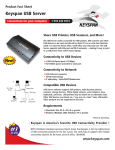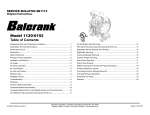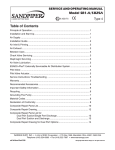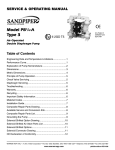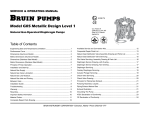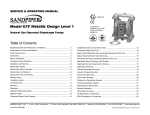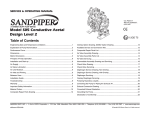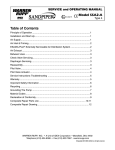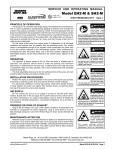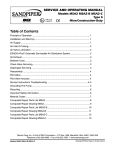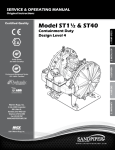Download Service Manual
Transcript
SERVICE & OPERATING MANUAL II 2GD T5 CE Model U1F Metallic Design Level 1 C ® LISTED Table of Contents (PRODUCT IDENTITY) xxx-xxx-xxx US U.S. Patent # 5,996,627 Other U.S. Patents Applied for Engineering Data and Temperature Limitations...................................................... 1 Available Service and Conversion Kits................................................................. 12 Explanation of Pump Nomenclature....................................................................... 2 Composite Repair Parts List................................................................................. 13 Performance Curve................................................................................................ 3 Air Distribution Valve Assembly Drawing and Parts List....................................... 14 Dimensions . .......................................................................................................... 4 Air Distribution Valve Servicing............................................................................. 15 Metric Dimensions ................................................................................................. 5 Pilot Valve Servicing, Assembly Drawing & Parts List.......................................... 16 Principle of Pump Operation................................................................................... 6 Diaphragm Service Drawing, with Overlay........................................................... 17 Installation and Start-Up......................................................................................... 6 Diaphragm Service Drawing, Non-Overlay........................................................... 17 Air Supply............................................................................................................... 6 Diaphragm Servicing............................................................................................ 18 Air Valve Lubrication............................................................................................... 6 Overlay Diaphragm Servicing . ............................................................................ 18 Air Line Moisture..................................................................................................... 6 Actuator Plunger Servicing................................................................................... 19 Air Inlet and Priming............................................................................................... 6 Check Valve Servicing.......................................................................................... 20 Between Uses........................................................................................................ 6 Check Valve Drawing............................................................................................ 20 Installation Guide.................................................................................................... 7 Muffler Drawing and Provision for Piping Air Exhaust.......................................... 21 Troubleshooting...................................................................................................... 8 Pumping Hazardous Liquids................................................................................. 21 Warranty................................................................................................................. 8 Converting Pump for Piping Exhaust Air.............................................................. 21 Recycling................................................................................................................ 9 Converted Exhaust Illustration.............................................................................. 21 Important Safety Information.................................................................................. 9 Grounding The Pump........................................................................................... 22 Material Codes..................................................................................................... 10 CE Declaration of Conformity............................................................................... 23 Composite Repair Parts Drawing......................................................................... 12 ATEX Declaration of Conformity........................................................................... 24 WARREN RUPP®, INC. • A Unit of IDEX Corporation • P.O. Box 1568, Mansfield, Ohio 44901-1568 USA • Telephone (419) 524-8388 • Fax (419) 522-7867 • www.warrenrupp.com u1fmdl1sm-REV0408 ©Copyright 2008 Warren Rupp, Inc. All rights reserved. II 2GD T5 Quality System ISO9001 Certified CE Environmental Management System ISO14001 Certified C 1" NPT(internal) 1" BSPT Tapered (internal) CAPACITY 0 to 45 gallons per minute (0 to 170 liters per minute) US ® LISTED U.S. Patent # 5,996,627 Other U.S. Patents Applied for INTAKE/DISCHARGE PIPE SIZE U1F (PRODUCT IDENTITY) xxx-xxx-xxx AIR VALVE No-lube, no-stall design SOLIDS-HANDLING Up to .25 in. (6mm) CAUTION! Operating temperature limitations are as follows: Materials Metallic Air-Operated Double Diaphragm Pump ENGINEERING, PERFORMANCE & CONSTRUCTION DATA HEADS UP TO 100 psi or 230.7 ft. of water (7 Kg/cm2 or 70 meters) DISPLACEMENT/STROKE .11 Gallon / .42 liter Operating Temperatures Maximum Minimum Nitrile General purpose, oil-resistant. Shows good solvent, oil, water and hydraulic fluid resistance. Should not be used with highly polar solvents like acetone and MEK, ozone, chlorinated hydrocarbons and nitro hydrocarbons. 190°F 88°C -10°F -23°C Neoprene All purpose. Resistant to vegetable oil. Generally not affected by moderate chemicals, fats, greases and many oils and solvents. Generally attacked by strong oxidizing acids, ketones, esters, nitro hydrocarbons and chlorinated aromatic hydrocarbons. 170°F 77°C -10°F -23°C Virgin PTFE Chemically inert, virtually impervious. Very few chemicals are known to react chemically with PTFE: molten alkali metals, turbulent liquid or gaseous fluorine and a few fluoro-chemicals such as chlorine trifluoride or oxygen difluoride which readily liberate free fluorine at elevated temperatures. 212°F 100°C -35°F -37°C Polypropylene 150°F 65°C -40°F -40°C Polyethylene 180°F 82°C -40°F -40°C For specific applications, always consult Warren Rupp's “Chemical Resistance Chart” SANDPIPER® pumps are designed to be powered only by compressed air. u1fmdl1sm-REV0408 Model U1F UL79 Listed Metallic Design Level 1 Page 1 Explanation of Pump Nomenclature U1F UL79 Listed Metallic · Design Level 1· Ball Valve Check Model Pump Pump Valve Design Wetted Brand Size Type Level Material U1F B1XBTXNS600. U1F B1XGTXNS600. U1FB1CBTCNS600. U1FB1CGTCNS600. U1F B1XBTXSS600. U1F B1XGTXSS600. Pump Brand U=UL79 Listed SANDPIPER® Pump Size 1F=1" Check Valve Type B=Ball Design Level 1= Design Level U U U U U U 1F 1F 1F 1F 1F 1F B B B B B B 1 1 1 1 1 1 Wetted Material X=Unpainted Aluminum C= Conductive Painted Aluminum Diaphragm Check Valve Materials B= Nitrile/Nitrile G= PTFE-Neoprene/PTFE X X C C X X Diaphragm/ Check Non-Wetted Shipping Check Valve Valve Material Porting Pump Pump Kit Weight Materials Seat Options Options Style Options Options lbs. (kg) B G B G B G T T T T T T Check Valve Seat T= PTFE Non-Wetted Material Options X=Unpainted Aluminum C= Conductive Painted Aluminum X X C C X X N N N N S S S S S S S S Porting Options N=NPT Threads B=BSPT (Tapered) Threads S= NPT Suction Port Facing Air Inlet, NPT Discharge Port Facing Air Exhaust 6 6 6 6 6 6 00. 00. 00. 00. 00. 00. 53 (24) 53 (24) 53 (24) 53 (24) 53 (24) 53 (24) Pump Style S=Standard Pump Options 6=Metal Muffler Model U1FB1XBTXNS600 is UL79 listed for pumping: Gasoline, Diesel Fuel, No. 4 Fuel Oils (or lighter), Motor Oil, Kerosene, Aviation Fuel and Water Model U1FB1XGTXNS600 is UL79 listed for pumping: Gasoline (Including Alcohol Blends up to 15%), Diesel Fuel, Motor Oil, No. 4 Oil (or lighter), Kerosene, Aviation Fuel, Automatic Transmission Fluid, Alcohol, Water, Waste Oil, Ethyl Alcohol, Methyl Alcohol and Ethylene Glycol. WARNING In the event of diaphragm rupture, pumped material may enter the air end of the pump, and be discharged into the atmosphere. If pumping a product which is hazardous or toxic, the air exhaust must be piped to an appropriate area for safe disposition. u1fmdl1sm-REV0408 Model U1F UL79 Listed Metallic Design Level 1 Page 2 Performance Curve, U1F UL79 Listed Metallic Design Level 1 MODEL U1F Metallic Performance Curve PSI 7 100 5(00) 100 6 25(00) SI (5 HEAD 5 3 60 60 PS ar) I (4.0 40 40(68) 30 25 20 15 10 5 9.1 7.6 6 4.5 3 1.5 ) I (2.72 2 Bar) 20 PSI (1.3 6 Bar) Air In 1 0 35(00) 8 Bar 40 PS 20 30(51) .44 B METERS 80 P FEET 80 4 10(17) PSI 15(00) (6.8 Bar 20(34) ) NPSHR BAR Performance based on the following: elastomer fitted pump, flooded suction, water at ambient conditions. The use of other materials and varying hydraulic conditions may result in deviations in excess of 5%. 0 0 5 0 20 let Pressure 10 40 15 60 20 25 30 U.S. Gallons per minute 80 100 120 35 40 140 45 160 50 180 Liters per minute CAPACITY u1fmdl1sm-REV0408 Model U1F UL79 Listed Metallic Design Level 1 Page 3 Dimensions: U1F UL79 LISTED Metallic Dimensions in Inches Dimensional Tolerance:±1/8" u1fmdl1sm-REV0408 Model U1F UL79 Listed Metallic Design Level 1 Page 4 Metric Dimensions: U1F UL79 Listed Metallic Dimensions in Millimeters Dimensional Tolerance:± 3mm u1fmdl1sm-REV0408 Model U1F UL79 Listed Metallic Design Level 1 Page 5 PRINCIPLE OF PUMP OPERATION This ball type check valve pump is powered by compressed air and is a 1:1 ratio design. The inner side of one diaphragm chamber is alternately pressurized while simultaneously exhausting the other inner chamber. This causes the diaphragms, which are connected by a common rod secured by plates to the centers of the diaphragms, to move in a reciprocating action. (As one diaphragm performs the discharge stroke the other diaphragm is pulled to perform the suction stroke in the opposite chamber.) Air pressure is applied over the entire inner surface of the diaphragm while liquid is discharged from the opposite side of the diaphragm. The diaphragm operates in a balanced condition during the discharge stroke which allows the pump to be operated at discharge heads over 200 feet (61 meters) of water. For maximum diaphragm life, keep the pump as close to the liquid being pumped as possible. Positive suction head in excess of 10 feet of liquid (3.048 meters) may require a back pressure regulating device to maximize diaphragm life. Alternate pressurizing and exhausting of the diaphragm chamber is performed by an externally mounted, pilot operated, four way spool type air distribution valve. When the spool shifts to one end of the valve body, inlet pressure is applied to one diaphragm chamber and the other diaphragm chamber exhausts. When the spool shifts to the opposite end of the valve body, the pressure to the chambers is u1fmdl1sm-REV0408 reversed. The air distribution valve spool is moved by a internal pilot valve which alternately pressurizes one end of the air distribution valve spool while exhausting the other end. The pilot valve is shifted at each end of the diaphragm stroke when a actuator plunger is contacted by the diaphragm plate. This actuator plunger then pushes the end of the pilot valve spool into position to activate the air distribution valve. The chambers are connected with manifolds with a suction and discharge check valve for each chamber, maintaining flow in one direction through the pump. INSTALLATION AND START-UP Locate the pump as close to the product being pumped as possible. Keep the suction line length and number of fittings to a minimum. Do not reduce the suction line diameter. For installations of rigid piping, short sections of flexible conductive hose should be installed between the pump and the piping. The flexible conductive hose reduces vibration and strain to the pumping system. A surge suppressor is recommended to further reduce pulsation in flow. AIR SUPPLY Air supply pressure cannot exceed 125 psi (8.6 bar). Connect the pump air inlet to an air supply of sufficient capacity and pressure required for desired performance. When the air supply line is solid piping, use a short length of flexible conductive hose not less than 1/2" (13mm) in diameter between the pump and the piping to reduce strain to the piping. The weight of the air supply line, regulators and filters must be supported by some means other than the air inlet cap. Failure to provide support for the piping may result in damage to the pump. A pressure regulating valve should be installed to insure air supply pressure does not exceed recommended limits. AIR VALVE LUBRICATION The air distribution valve and the pilot valve are designed to operate WITHOUT lubrication. This is the preferred mode of operation. There may be instances of personal preference or poor quality air supplies when lubrication of the compressed air supply is required. The pump air system will operate with properly lubricated compressed air supply. Proper lubrication requires the use of an air line lubricator (available from Warren Rupp) set to deliver one drop of SAE 10 non-detergent oil for every 20 SCFM (9.4 liters/sec.) of air the pump consumes at the point of operation. Consult the pump’s published Performance Curve to determine this. AIR INLET AND PRIMING To start the pump, open the air valve approximately 1/2" to 3/4" turn. After the pump primes, the air valve can be opened to increase air flow as desired. If opening the valve increases cycling rate, but does not increase the rate of flow, cavitation has occurred. The valve should be closed slightly to obtain the most efficient air flow to pump flow ratio. BETWEEN USES When the pump is used for materials that tend to settle out or solidify when not in motion, the pump should be flushed after each use to prevent damage. (Product remaining in the pump between uses could dry out or settle out. This could cause problems with the diaphragms and check valves at restart.) In freezing temperatures the pump must be completely drained between uses in all cases. AIR LINE MOISTURE Water in the compressed air supply can create problems such as icing or freezing of the exhaust air, causing the pump to cycle erratically or stop operating. Water in the air supply can be reduced by using a point-of-use air dryer to supplement the user’s air drying equipment. This device removes water from the compressed air supply and alleviates the icing or freezing problems. Model U1F UL79 Listed Metallic Design Level 1 Page 6 INSTALLATION GUIDE Top Discharge Ball Valve Pump 1 Surge Suppressor 1 2 Filter/Regulator 3 Air Dryer CAUTION Use a gasoline-resistant pipe compound to make pipe joints tight. Pump shall be installed in accordance to Flammable and Combustible Liquids Code, NFPA 30 or the Automotive and Marine Service Station Code, NFPA 30A, as appropriate to the intended use of the pump. CAUTION The air exhaust should be piped to an area for safe disposition of the product being pumped, in the event of a diaphragm failure. WARNING To maintain conductivity, do not paint the pump, or if painted, use a conductive paint or coating. 2 3 The pump must be rigidly mounted with fasteners to a conductive base or natural ground. u1fmdl1sm-REV0408 Model U1F UL79 Listed Metallic Design Level 1 Page 7 TROUBLESHOOTING Possible Symptoms: • Pump will not cycle. • Pump cycles, but produces no flow. • Pump cycles, but flow rate is unsatisfactory. • Pump cycle seems unbalanced. • Pump cycle seems to produce excessive vibration. What to Check: Excessive suction lift in system. Corrective Action: For lifts exceeding 20 feet (6 meters), filling the pumping chambers with liquid will prime the pump in most cases. What to Check: Excessive flooded suction in system. Corrective Action: For flooded conditions exceeding 10 feet (3 meters) of liquid, install a back pressure device. What to Check: System head exceeds air supply pressure. Corrective Action: Increase the inlet air pressure to the pump. Most diaphragm pumps are designed for 1:1 pressure ratio at zero flow. What to Check: Air supply pressure or volume exceeds system head. Corrective Action: Decrease inlet air pressure and volume to the pump as calculated on the published PERFORMANCE CURVE. Pump is cavitating the fluid by fast cycling. u1fmdl1sm-REV0408 What to Check: Undersized suction line. Corrective Action: Meet or exceed pump connection recommendations shown on the DIMENSIONAL DRAWING. W h a t t o C h e ck : R e s t r i c t e d o r undersized air line. Corrective Action: Install a larger air line and connection. Refer to air inlet recommendations shown in your pump’s SERVICE MANUAL. What to Check: Check ESADS, the Externally Serviceable Air Distribution System of the pump. Corrective Action: Disassemble and inspect the main air distribution valve, pilot valve and pilot valve actuators. Refer to the parts drawing and air valve section of the SERVICE MANUAL. Check for clogged discharge or closed valve before reassembly. What to Check: Rigid pipe connections to pump. Corrective Action: Install flexible connectors and a surge suppressor. What to Check: Blocked air exhaust muffler. Corrective Action: Remove muffler screen, clean or de-ice and reinstall. Refer to the Air Exhaust section of your pump SERVICE MANUAL. What to Check: Pumped fluid in air exhaust muffler. Corrective Action: Disassemble pump chambers. Inspect for diaphragm rupture or loose diaphragm plate assembly. Refer to the Diaphragm Replacement section of your pump SERVICE MANUAL. What to Check: Suction side air leakage or air in product. Corrective Action: Visually inspect all suction side gaskets and pipe connections. What to Check: Obstructed check valve. Corrective Action: Disassemble the wet end of the pump and manually dislodge obstruction in the check valve pocket. Refer to the Check Valve section of the pump SERVICE MANUAL for disassembly instructions. What to Check: Worn or misaligned check valve or check valve seat. Corrective Action: Inspect check valves and seats for wear and proper seating. Replace if necessary. Refer to Check Valve section of the pump SERVICE MANUAL for disassembly instructions. What to Check: Blocked suction line. Corrective Action: Remove or flush obstruction. Check and clear all suction screens and strainers. What to Check: Blocked discharge line. C o r r e c t i v e A c t i o n : C h e ck fo r obstruction or closed discharge line valves. What to Check: Blocked pumping chamber. Corrective Action: Disassemble and inspect the wetted chambers of the pump. Remove or flush any obstructions. Refer to the pump SERVICE MANUAL for disassembly instructions. What to Check: Entrained air or vapor lock in one or both pumping chambers. Corrective Action: Purge chambers through tapped chamber vent plugs. PURGING THE CHAMBERS OF AIR CAN BE DANGEROUS! Contact the Warren Rupp Technical Services Department before performing this procedure. Any model with top-ported discharge will reduce or eliminate problems with entrained air. If your pump continues to perform below your expectations, contact your local Warren Rupp Distributor or factory Technical Services Group for a service evaluation. WARRANTY Refer to the enclosed Warren Rupp Warranty Certificate. Model U1F UL79 Listed Metallic Design Level 1 Page 8 RECYCLING IMPORTANT SAFETY INFORMATION Many components of SANDPIPER® Metallic AODD pumps are made of recyclable materials (see chart on page 10 for material specifications). We encourage pump users to recycle worn out parts and pumps whenever possible, after any hazardous pumped fluids are thoroughly flushed. IMPORTANT Read these safety warnings and instructions in this manual completely, before installation and start-up of the pu m p . I t i s t h e responsibility of the purchaser to retain this manual for reference. Failure to comply with the recommendations stated in this manual will damage the pump, and void factory warranty. WARNING Take action to prevent static sparking. Fire or explosion c a n r e s u l t , e s p e c i a l ly when handling flammable liquids. The pump, piping, valves, containers or other miscellaneous equipment must be grounded. (See page 22) WARNING This pump is pressurized internally with air pressure during operation. Always make certain that all bolting is in good condition and that all of the correct bolting is reinstalled during assembly. CAUTION CE Pump complies with EN809 Pumping Directive and Directive 98/37/EC Safety of Machinery, and Directive 94/9/ EC,EN 13463-1 Equipment fo r u s e i n p o t e n t i a l l y Explosive Environments. For reference to the directive certificates visit: www.warrenrupp.com. The Technical File AX1 is stored at KEMA, Notified Body 0344, under Document #203040000. Underwriters Laboratories, Inc., an Internationally C ® US recognized independent organization for testing LISTED products to ensure public safety. (PRODUCT IDENTITY) xxx-xxx-xxx u1fmdl1sm-REV0408 Before pump operation, inspect all gasketed fasteners for looseness caused by gasket creep. Retorque loose fasteners to prevent leakage. Follow recommended torques stated in this manual. WARNING WARNING Do not smoke near the pump or use the pump near an open flame. Fire or explosion could result. WARNING Do not use this pump with potable water or fluids for human consumption. Before maintenance or repair, shut off the compressed air line, bleed the pressure, and disconnect the air line from the pump. The discharge line may be pressurized and must be bled of its pressure. WARNING In the event of diaphragm rupture, pumped material may enter the air end of the pump, and be discharged into the atmosphere. If pumping a product which is hazardous or toxic, the air exhaust must be piped to an appropriate area for safe disposition. WARNING When used for toxic or aggressive fluids, the pump should always be flushed clean prior to disassembly. WARNING Before doing any maintenance on the pump, be certain all pressure is completely vented from the pump, suction, discharge, piping, and all other openings and connections. Be certain the air supply is locked out or made non‑operational, so that it cannot be started while work is being done on the pump. Be certain that approved eye protection and protective clothing are worn all times in the vicinity of the pump. Failure to follow these recommendations may result in serious injury or death. WARNING Airborne particles and loud noise hazards. Wear ear protection. and eye Model U1F UL79 Listed Metallic Design Level 1 Page 9 u1fmdl1sm-REV0408 Model U1F UL79 Listed Metallic Design Level 1 Page 10 u1fmdl1sm-REV0408 Model U1F UL79 Listed Metallic Design Level 1 Page 11 Composite Repair Parts Drawing Add Kits: 476-230-000 476-213-760 476-213-635 AIR END KIT (Available Service Kits:) 8 Air End Kit Seals, O-Rings, Gaskets, Retaining Rings, Air Valve Assembly and Pilot Valve Assembly Wetted End Kit Nitrile Diaphragms, Nitrile Check Balls and PTFE Check Valve Seats Wetted End Kit Neoprene Backup Diaphragms, PTFE Overlay Diaphragms, PTFE Check Balls and PTFE Check Valve Seat 18 11 4 32 17 ATTACH EYELET TO ONE OF THE FOUR CAPSCREWS ITEM #11 31 25 12 20 7 22 9 26 30 2 3 28 16 21 1 5 29 27 13 6 10 23 14 14 15 24 2 23 29 OPTIONAL OVERLAY 19 30 9 u1fmdl1sm-REV0408 Model U1F UL79 Listed Metallic Design Level 1 Page 12 Composite Repair Parts List ITEM 1 2 3 4 5 6 7 8 9 10 11 12 13 14 15 16 PART NUMBER DESCRIPTION 031-183-000 050-028-760 050-028-600 070-012-170 095-110-000 114-025-157 132-019-360 135-036-506 165-120-157 170-044-330 170-045-330 170-069-330 170-006-330 196-173-156 286-008-760 286-008-365 286-015-604 360-093-360 Air Valve Assembly Ball, Check Ball, Check Bushing Pilot Valve Assembly Intermediate Bumper Bushing Cap, Air Inlet Assembly Capscrew, Hex Hd 5/16-18 X 1.00 Capscrew, Hex Hd 5/16-18 X 1.25 Capscrew, Hex Hd 5/16-18 X 1.75 Capscrew, Hex Hd 3/8-16 X 1.00 Chamber, Outer Diaphragm Diaphragm Diaphragm, Overlay Gasket, Air Valve u1fmdl1sm-REV0408 QTY 1 4 4 2 1 1 2 2 1 16 16 4 4 2 2 2 2 1 ITEM 17 18 19 20 21 22 23 24 25 26 27 28 29 30 31 32 PART NUMBER DESCRIPTION 360-103-360 360-104-379 518-175-156 518-175-156E 518-176-156 518-176-156E 530-033-000 560-001-379 612-022-330 612-108-157 620-022-115 675-042-115 685-060-120 720-010-375 722-098-600 900-004-330 901-038-330 920-025-000 Gasket, Pilot Valve Gasket, Air Inlet Manifold, Suction Manifold, Suction 1" BSPT (Tapered) Manifold, Discharge Manifold, Discharge 1" BSPT (Tapered) Metal Muffler O-Ring Plate, Inner Diaphragm Plate, Outer Diaphragm Assembly Pin, Actuator Ring, Retaining Rod, Diaphragm Seal, U-Cup Seat, Check Ball Lockwasher Flatwasher Ground Strap QTY 1 1 1 1 1 1 1 2 2 2 2 2 1 2 4 16 4 1 Model U1F UL79 Listed Metallic Design Level 1 Page 13 Air Valve Assembly Drawing, Parts List 1-F 1-E 1-D 1-D 1-C 1-B 1-B 1-E AIR VALVE ASSEMBLY PARTS LIST ITEM 1 1-A 1-B 1-C 1-D 1-E 1-F PART NUMBER 031-183-000 095-109-157 031-139-000 132-029-357 560-020-360 165-127-157 170-032-330 DESCRIPTION Gas Valve Assembly Valve Body Sleeve and Spool Set Bumper O-Ring Cap, End Capscrew QTY 1 1 1 2 10 2 8 1-A 1-C 1-D 1-F u1fmdl1sm-REV0408 Model U1F UL79 Listed Metallic Design Level 1 Page 14 AIR DISTRIBUTION VALVE SERVICING To service the air valve first shut off the compressed air, bleed pressure from the pump, and disconnect the air supply line from the pump. STEP #1: See COMPOSITE REPAIR PARTS DRAWING. Using a 9/16" wrench or socket, remove the four hex head capscrews (item 10). Remove the air valve assembly from the pump. Remove and inspect gasket (item 16) for cracks or damage. Replace gasket if needed. STEP #2: Disassembly of the air valve. Using a 7/16" wrench or socket, remove the eight hex caprscrews (item 1-F) that fasten the end caps to the valve body. Next remove the two end caps (items 1-E). Inspect two o-rings (items 1-D) on each end cap for damage or wear. Replace the o-rings as needed. Remove the bumpers (items 1-C). Inspect the bumpers for damage or wear. Remove the spool (part of item 1-A) from the sleeve. Be careful not to scratch or damage the outer diameter of the spool. Wipe spool with a soft cloth and inspect for scratches or wear. u1fmdl1sm-REV0408 Inspect the inner diameter of the sleeve (part of item 1-A) for dirt, scratches, or other contaminants. Remove the sleeve if needed and replace with a new sleeve and spool set (item 1-A). STEP #3: Reassembly of the air valve. Install one bumper (item 1-C) and one end cap (item 1-E) with two o-rings (item 1-D) and fasten with four hex capscrews (items (1-F) to the valve body (items 1-A). Remove the new sleeve an spool set (item 1-A) from the plastic bag. Carefully remove the spool from the sleeve. Install the six o-rings (item 1-G) into the six grooves on the sleeve. Apply a light coating of grease to the o-rings before installing the sleeve into the valve body (item 1-B), align the slots in the sleeve with the slots in the valve body. Insert the spool into the sleeve. Be careful not to scratch or damage the spool during installation. Push the spool in until it touches the bumper on the opposite end. Install the remaining bumper, end cap (with o-rings), and fasten with the remaining hex capscrews. Fasten the air valve assembly (item 1) and gasket (item 16) to the pump. Connect the compressed air line to the pump. The pump is now ready for operation. IMPORTANT Read these instructions c o m p l e t e l y, b e fo r e installation and start-up. It is the responsibility of the purchaser to retain this manual for reference. Failure to comply with the recommendations stated in this manual will damage the pump, and void factory warranty. Model U1F UL79 Listed Metallic Design Level 1 Page 15 Pilot Valve Servicing, Assembly Drawing & Parts List pilot valve assembly parts list Item 4 4-A 4-B 4-C 4-D 4-E 4-F Part Number 095-110-000 095-095-157 755-052-000 560-033-360 775-055-000 560-023-360 675-037-080 Description Pilot Valve Assembly Valve Body Sleeve (With O-rings) O-ring (Sleeve) Spool (With O-rings) O-ring (Spool) Retaining Ring Pilot Valve Servicing To service the pilot valve first shut off the compressed air supply, bleed the pressure from the pump, and disconnect the air supply line from the pump. STEP #1: See pump assembly drawing. Using a 1/2" wrench or socket, remove the four capscrews (item 12). Remove the air inlet cap (item 8) and air inlet gasket (item 18). The pilot valve assembly (item 4) can now be removed for inspection and service. u1fmdl1sm-REV0408 Qty 1 1 1 6 1 3 1 STEP #2: Disassembly of the pilot valve. Remove the pilot valve spool (item 4-D). Wipe clean and inspect spool and o-rings for dirt, cuts or wear. Replace the o-rings and spool if necessary. Remove the retaining ring (item 4-F) from the end of the sleeve (item 4-B) and remove the sleeve from the valve body (item 4-A). Wipe clean and inspect sleeve and o-rings for dirt, cuts or wear. Replace the o-rings and sleeve if necessary. STEP #3: Re-assembly of the pilot valve. Generously lubr icate outside diameter of the sleeve and o-rings. Then carefully insert sleeve into valve body. Take CAUTION when inserting sleeve, not to shear any o-rings. Install retaining ring to sleeve. Generously lubricate outside diameter of spool and o-rings. Then carefully insert spool into sleeve. Take CAUTION when inserting spool, not to shear any o-rings. Use BP-LS-EP-2 multipurpose grease, or equivalent. STEP #4: Re-install the pilot valve assembly into the intermediate. Be careful to align the ends of the pilot valve stem between the plunger pins when inserting the pilot valve into the cavity of the intermediate. Re-install the gasket, air inlet cap and capscrews. Connect the air supply to the pump. The pump is now ready for operation. Model U1F UL79 Listed Metallic Design Level 1 Page 16 Diaphragm Service Drawing, with Overlay Diaphragm Service Drawing, Non-Overlay 6 5 6 23 23 14 24 28 14 11 15 5 28 13 24 11 13 u1fmdl1sm-REV0408 Model U1F UL79 Listed Metallic Design Level 1 Page 17 DIAPHRAGM SERVICING To service the diaphragms first shut off the suction, then shut off the discharge lines to the pump. Shut off the compressed air supply, bleed the pressure from the pump and disconnect the air supply line from the pump. Drain any remaining liquid from the pump. Step #1: See the pump assembly drawing and the diaphragm servicing illustration. Using a 1/2” wrench or socket, remove the 16 capscrews (item 9) that fasten the manifolds (items 19 & 20) to the outer chambers (item 13). Step #2: Removing outer chambers. Using a 1/2” wrench or socket, remove the 16 capscrews (item 11), that fasten the outer chambers (item 13), diaphragms (item 14) and intermediate (item 5) together. Step #3: Removing the diaphragms and diaphragm plates. Use a 7/8” wrench or six point socket to remove the outer diaphragm plate assemblies (item 24), diaphragms (item 14) and inner diaphragm plates (item 23) from the diaphragm rod (item 28) by turning counterclockwise. Inspect the diaphragm for cuts, punctures, abrasive wear or chemical attack. Replace the diaphragms if necessary. DO NOT USE A WRENCH ON THE DIAPHRAGM ROD. FLAWS ON THE SURFACE MAY DAMAGE BEARINGS AND SEALS. u1fmdl1sm-REV0408 Step #4: Assembling the diaphragm and diaphragm plates to the diaphragm rod. Push the threaded stud of one outer diaphragm plate assembly through the center of one diaphragm and through one inner diaphragm plate. Install the diaphragm with the natural bulge facing away from the diaphragm rod and make sure the radius on the inner diaphragm plate is towards the diaphragm, as indicated on the diaphragm servicing illustration. Thread the assembly onto the diaphragm rod, leaving loose. Align one diaphragm with the intermediate and install the outer chamber to the pump using the 8 capscrews. Tighten the opposite diaphragm plate until the holes in the diaphragm align with the holes in the intermediate. Then, install the other outer chamber using the 8 capscrews. Step #5: Installing the diaphragm and rod assembly to the pump. Make sure the bumper (item 6) is installed over the diaphragm rod. Insert rod into pump. On the opposite side of the pump, pull the diaphragm rod out as far as possible. Make sure the second bumper is installed over the diaphragm rod. Push the threaded stud of the other outer diaphragm plate assembly through the center of the other diaphragm and through the other inner diaphragm plate. Make sure the radius on the inner diaphragm plate is towards the diaphragm. Thread the assembly onto the diaphragm rod. Use a 7/8” wrench or socket to hold one outer diaphragm plate. Then, use a torque wrench to tighten the other outer diaphragm plate to the diaphragm rod to 350 in. lbs. (39.5 Newton meters). OVERLAY DIAPHRAGM SERVICING The overlay diaphragm (item 15) is designed to fit over the exterior of the standard diaphragm (item 14). Follow the same procedures described for the standard diaphragm for removal and installation, except tighten the outer diaphragm plate assembly, diaphragms and inner diaphragm plate to the diaphragm rod to 350 in. lbs. (39.5 Newton meters). Step #6: Reinstall the manifolds to the pump using the 16 capscrews. The pump is now ready to be reinstalled, connected and returned to operation. IMPORTANT Read these instructions c o m p l e t e l y, b e fo r e installation and start-up. It is the responsibility of the purchaser to retain this manual for reference. Failure to comply with the recommendations stated in this manual will damage the pump, and void factory warranty. Model U1F UL79 Listed Metallic Design Level 1 Page 18 ACTUATOR PLUNGER SERVICING To service the actuator plunger first shut off the compressed air supply, bleed the pressure from the pump, and disconnect the air supply line from the pump. Step #1: See pump assembly drawing. Using a 1/2" wrench or socket, remove the four capscrews (items 11). Remove the air inlet cap (item 8) and air inlet gasket (item 18). The pilot valve assembly (item 4) can now be removed. Step #2: Inspect the actuator plungers. See ILLUSTRATION AT RIGHT. The actuator plungers (items 25) can be reached through the pilot valve cavity in the intermediate assembly (item 5). Remove the plungers (item 25) from the bushings (item 7) in each end of the cavity. Inspect the installed o-ring (items 22) for cuts and/or wear. Replace the o-rings if necessary. Apply a light coating of grease to each o-ring and re-install the plungers in to the bushings. Push the plungers in as far as they will go. To remove the bushings (item 7), first remove the retaining rings (item 26) by using a flat screwdriver. NOTE: It is recommended that new retaining rings be installed. u1fmdl1sm-REV0408 Step #3: Re-install the pilot valve assembly into the intermediate assembly. Be careful to align the ends of the stem between the plungers when inserting the stem of the pilot valve into the cavity of the intermediate. Re-install the gasket (item 18), air inlet cap (item 8) and capscrews (item 11). Connect the air supply to the pump. The pump is now ready for operation. IMPORTANT Read these instructions c o m p l e t e l y, b e f o r e installation and start-up. It is the responsibility of the purchaser to retain this manual for reference. Failure to comply with the recommendations stated in this manual will damage the pump, and void factory warranty. ACTUATOR PLUNGER SERVICING 25 22 7 26 5 Model U1F UL79 Listed Metallic Design Level 1 Page 19 CHECK VALVE SERVICING Before servicing the check valve components, first shut off the suction line and then the discharge line to the pump. Next, shut off the compressed air supply, bleed air pressure from the pump, and disconnect the air supply line from the pump. Drain any remaining fluid from the pump. The pump can now be removed for service. To a c c e s s t h e c h e c k va l ve components, remove the manifold (item 20 or item 19 not shown). Use a 1/2" wrench or socket to remove the fasteners. Once the manifold is removed, the check valve components can be seen. Inspect the check balls (items 2) for wear, abrasion, or cuts on the spherical surface. The check valve seats (item 30) should be inspected for cuts, abrasive wear, or embedded material on the surfaces of both the external and internal chambers. The spherical surface of the check balls must seat flush to the surface of the check valve seats for the pump to operate to peak efficiency. Replace any worn or damaged parts as necessary. Re-assemble the check valve components. The seat should fit into the counter bore of the outer chamber. The pump can now be reassembled, reconnected and returned to operation. u1fmdl1sm-REV0408 Check Valve Drawing 20 9 30 2 29 Model U1F UL79 Listed Metallic Design Level 1 Page 20 PUMPING HAZARDOUS LIQUIDS When a diaphragm fails, the pumped liquid or fumes enter the air end of the pump. Fumes are exhausted into the surrounding environment. When pumping hazardous or toxic materials, the exhaust air must be piped to an appropriate area for safe disposal. See illustration #1 at right. This pump can be submerged if the pump materials of construction are compatible with the liquid being pumped. The air exhaust must be piped above the liquid level. See illustration #2 at right. Piping used for the air exhaust must not be smaller than 1" (2.54 cm) diameter. Reducing the pipe size will restrict air flow and reduce pump performance. When the pumped product source is at a higher level than the pump (flooded suction condition), pipe the exhaust higher than the product source to prevent siphoning spills. See illustration #3 at right. Converting the pump for piping the exhaust air The following steps are necessary to convert the pump to pipe the exhaust air away from the pump. Remove the muffler (item 21). The air distribution valve (item 1) has 1" NPT threads for piped exhaust. IMPORTANT INSTALLATION NOTE: The manufacturer recommends installing a flexible conductive hose or connection between the pump and any rigid plumbing. This reduces stresses on the molded threads of the air exhaust port. Failure to do so may result in damage to the air distribution valve body. Any piping or hose connected to the pump’s air exhaust port must be conductive and physically supported. Failure to support these connections could also result in damage to the air distribution valve body. CONVERTED EXHAUST ILLUSTRATION PUMP INSTALLATION AREA SAFE AIR ExHAUST DISPOSAL AREA 1" DIAMETER AIR ExHAUST PIPING MUFFLER Illustration #1 Air Valve Assembly MUFFLER 1 LIQUID LEVEL 1" DIAMETER AIR ExHAUST PIPING SUCTION LINE 21 Illustration #2 MUFFLER The pump comes equipped with a standard metal muffler LIQUID LEVEL 1" DIAMETER AIR ExHAUST PIPING SUCTION LINE Illustration #3 u1fmdl1sm-REV0408 Model U1F UL79 Listed Metallic Design Level 1 Page 21 Grounding The Pump One eyelet is fastened to the pump hardware. One eyelet is installed to a true earth ground. (Requires a 5/16 or 8mm maximum diameter bolt) This 8 foot long (244 centimeters) Ground Strap (Item 32) is shipped with the eyelet end fastened to the pump hardware. To reduce the risk of static electrical sparking, this pump must be grounded. Check the local electrical code for detailed grounding instruction and the type of equipment required, or in the absence of local codes, an industry or nationally recognized code having jurisdiction over specific installations and installation codes. WARNING Take action to prevent static sparking. Fire or explosion can result, especially when handling flammable liquids. The pump, piping, valves, containers or other miscellaneous equipment must be grounded. u1fmdl1sm-REV0408 Model U1F UL79 Listed Metallic Design Level 1 Page 22 Declaration of Conformity Warren Rupp, Inc., 800 North Main Street, Mansfield, Ohio, certifies that Air-Operated Double Diaphragm Pumps Series: HDB, HDF, M Non-Metallic, S Non-Metallic, M Metallic, S Metallic, Containment Duty, Gas, UL, High Pressure, W, Submersible and Tranquilizers comply with the European Community Directive 98/37/EC, Safety of Machinery. This product has used EN 809, Pumps and Pump Units for Liquids - Common Safety Requirements harmonized standard to verify conformance. October 20, 2005 Signature of authorized person Date of issue David Roseberry Engineering Manager Printed name of authorized person Title CE Declaration of Conformity ATEX 100a In accordance with Directive 94/9/EC, Annex VIII Equipment intended for use in potentially explosive environments. Technical File No. AX1 is stored at KEMA, Notified Body 0344, under document number 203040000. Manufacturer: Warren Rupp, Inc. 800 North Main Street P.O. Box 1568 Mansfield, OH 44902 USA Applicable Standard: 94/9/EC EN13463-1 For potentially explosive environments Group I, Category M2 Group II, Category 2 GD Models: Air-Operated Double Diaphragm Metallic Pumps Series: EH, ET, G, HDB, HDF, M, MHP, MS, MP, SH, S, SA, SB, ST, T and U under SANDPIPER® and MARATHON® Brands Metal Surge Suppressors Series: T and MSS under Tranquilizer® and MARATHON® Brands Air-Operated Double Diaphragm Nonmetallic Conductive Acetal Pump Models: PB¼ and S05 Air-Operated Double Diaphragm Nonmetallic Conductive Polypropylene Pump Models: S05, S1F, S15, S20 SANDPIPER ® ® A WARREN RUPP PUMP BRAND DATE/APPROVAL/TITLE: 8 May 2003 Rev F 12 January 2007 A WARREN RUPP PUMP BRAND David Roseberry, Engineering Manager


























